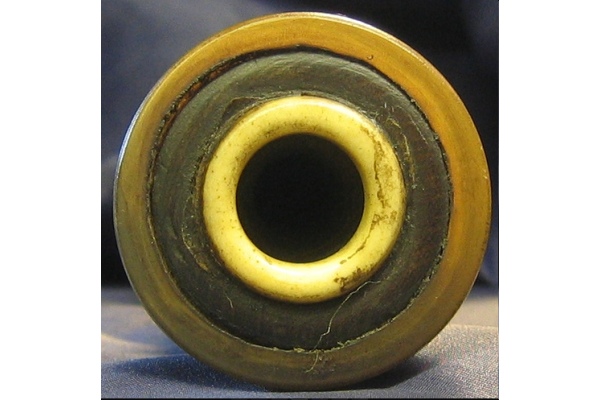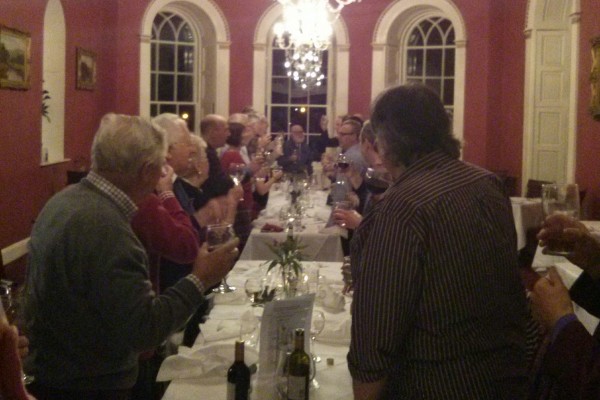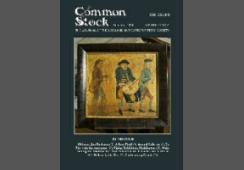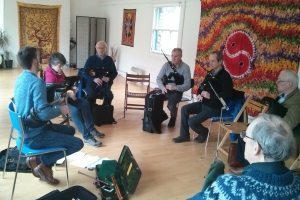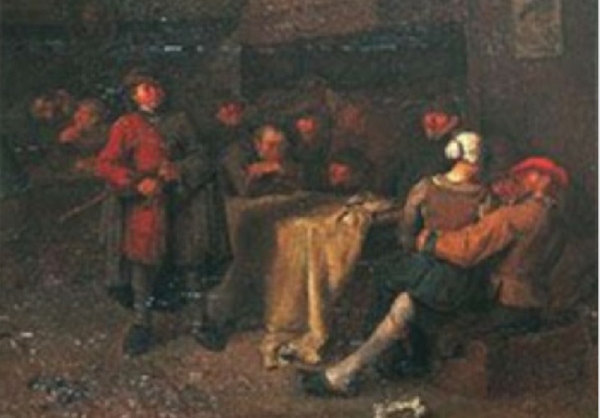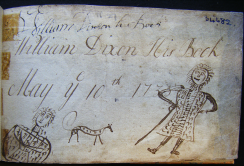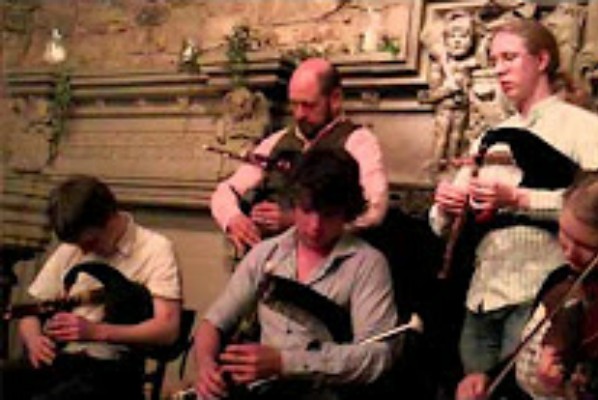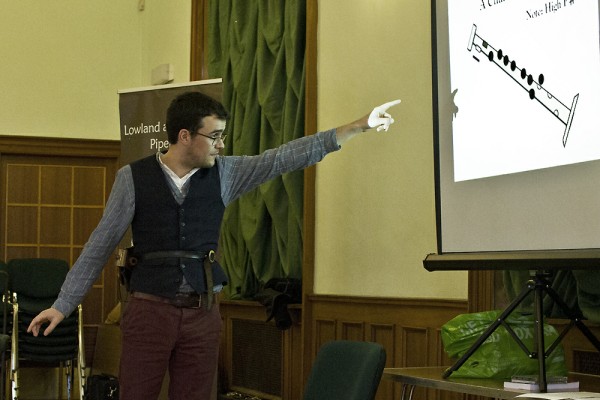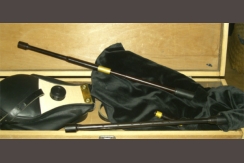




Pete Stewart gave a talk on early music at the annual Collogue (see elsewhere in this issue), and here he homes in on one particular tune.
Some time around 1500, the poet Dunbar complained to the merchants of Edinburgh that “your commone menstrallis hes no tune
bot ‘Now the day dawes' and 'Into June' “
and they were still playing it 100 years later. In his elegy to Habbie Simson [see page 21],
Robert Sempell asked
‘Now wha shall play the Day it Dawis or Hunt Up when the cock he crawis’
Despite the different titles mentioned in these references, it seems reasonable to assume that ‘Now the day dawes’ represents the same tune as ‘The Day it Dawis’. This is confirmed by the earliest reference I have found to the title, in a verse from around 1400:
‘The day dawes, the Crowe croudes, The lurkis synge, the cokkes crowe, The waytes faste ther pipes blowe.’
The ‘waytes’ here are the Civic musicians, and their ‘pipes’ are probably shawms.. A prece- dent has been set however, for the poem which is now frequently associated with this title, that by Alexander Montgomerie (ca. 1545- ca. 1611), “The Nicht is Neir Gane”, (probably written before 1586) which opens with the verse
‘Hey! nou the day dawis; The jolie cok crauis, Nou shroudis the shawis Throu natur anone.
The Thrisell-cok cryis On lovers wha lyis, Nou skailiis the skyis; The nicht is neir gane.’
Now these particular words can clearly not have provoked the waits’ tune, since Dunbar’s reference to the tune predates them by perhaps 80 years. If they are related, then the words were written to suit the tune. What was this tune? For anyone who has read the available comments on the town Pipers' repertoire, this question is easily answered. Indeed, it was answered in Common Stock vol 17 no 1 (June 2002) [page 14].
“.. .the kind of tunes Lowland and Border toun pipers commonly used to rouse the commu- nity in the morning - The Hunts Up and The Day it Dawes, the latter perhaps better known as Hey Tuttie Tattie, or more latterly, Scots Wha’Hae.”
The earliest printed version of this tune is in Oswald’s Caledonian Pocket Companion, Book iii, c. 1750. The version here is that given as Now the Day Dawes in Stenhouse’s Illustrations to The Scots Musical Museum (1803).
Now, there does seem to be some evidence that a tune of the structure of ‘Tutti Tatti’ was around not long after Bannockburn, as has been widely discussed. However, here is what Frank Kidson said about ‘Tutti Tatti’ in Grove's Musical Dictionary in 1903;
“In tracing the history of the tune further back, we find the version in Johnson’s Scots Musi- cal Museum, vol. ii., 1788, as Hey Tutti Taiti, with a couple of songs to the same air. The first, a foolish drinking-song, begins
Landlady, count the lawin’ The day is near the dawin’ Ye’re a’ blind drunk, boys And I’m but jolly fou.
.............. the second is a Jacobite Song in praise of Charles XII., King of Sweden, com- mencing: ‘Here’s to the King, Sir’. A line in the song explains the apparently nonsensical phrase that gives a title to the air: ‘when you hear the trumpet sound tutti, taitie to the drum’. The words are evidently a vocal imitation of a trumpet- call.
Upon the line in the first song, ‘The day is near the dawin’, has been built up a tissue of fan- ciful statements which are unsupported by any reasonable conclusion. In Gavin Douglas's translation of Virgil, 1513, and in other places, a Scottish song is mentioned whose first line was ‘Hey now the day dawis’. In Sibbald’s Chronicle of Scottish Poetry, 1802, this myth is presented probably for the first time. It is there stated that the tune for ‘Hey now the day dawis’ is the same as Hey Tutti Tatti. Stenhouse, in his notes to Johnson’s Museum, again promulgates the fiction.”
I am inclined to accept Kidson’s argument. The fact that the words appear in SMM aligned with the music does not mean that they can be readily sung to the tune, though it is not im- possible. A comparison of the drinking song words given above with those of Montgomerie well displays the problem; the most natural rhythmic structure for Montgomerie’s words would be that of the tune ‘Li llibulero’.
So, it seems there is little evidence for Tutti Tatti as the tune of the Waits, apart from its pos- sible age and the fact that bagpipe versions exist (though most versions, including the one here, require a sixth below the tonic). Are there other contenders?
I have been unable to find any reference to Now the Day Dawis in Gavin Douglas’ transla- tion of Virgil, as mentioned by Stonehouse. The prologue to Book 13, which is usually the verse said to contain the reference, is concerned with the close of day. However, in the Ad- ditional Illustrations to The Scots Musical Museum (p533 DLXXVII Add.Illust.) there is another tune called ‘The Day Dawis’.
This tune is taken from the Straloch manuscript, c. 1627. Unfortunately, this manuscript was lost, and the only surviving copy, made by G. Graham in 1847 (NLS MS adv. 5.2.18) is ex- tremely difficult to interpret. (A concordance for this tune is said to be in the Wemys MS but I have not seen this.) However, the SMM version is sufficient to suggest how it should be read, and it is included here in full. It can be seen to be a more extended setting than that in the Additional Illustrations, (which was presumably taken from the original manuscript). It can also be seen to be possibly even less suited to Montgomerie’s words. It would, how- ever, not be too difficult to generate a bagpipe version, by combining parts 2 and 3 (using mostly part 3, except for the last two bars, thereby avoiding the ninth, or indeed playing the ninth if you can). This new second part would have to be transposed up a fourth.
In ‘Scotland's Music’, John Purves points out that perhaps the answer has been with us all the time, hidden in the Shetland repertoire. ‘Da Day Dawes’ is a New Year tune, tradition- ally played only then. It is, however, a tune of the kind we might imagine Dunbar complain- ing of; its simple hypnotic repetition of few notes was perhaps likely to have little appeal to a cultivated imagination especially if less than well played. Unfortunately, this is not as it stands a pipe tune. To make it so we would have to accept flattened thirds and remove four beats from the irregularity of the closing phrases. Added to which the tune is recognised as being peculiar to the stringed instrument ‘native’ to the Shetlands, the ‘gue’ (see Scotland’s
Scotland’s Music, p.79). All in all it seems it cannot really be considered as a basic lowland pipers’ tune.
However, there is a further Day Dawes tune of sufficient age. It is to be found in the Fayr- fax manuscript (BM Ms. Add. 31992) which dates from around 1500. The words are put into the mouth of a “comely queen” :
‘This day day dawes, This gentill day dawes, And I must home gone.
This is one of the devotional pieces in the manuscript, in which sacred and secular distinc- tions are blurred (the ‘lily-white rose’, for example, that is mentioned in ‘this day dawes’ is both symbolic of the Virgin, and the emblem of Elizabeth of York, who married Henry VII, King of England, in 1485). At least this tune is sufficiently old to be the one referred to by Dunbar. It is an elaborate three-part setting, however, and a pipe tune would take some ex- tracting. Or at least, that was my first impression. Embedded in the densely woven parts is a three bar section in an anomalous compound rhythm. This seems to be a feature of many French ‘chansons’, apparently used to represent the spring (thanks to John Goodacre for this information). On closer examination, I noticed that these few bars are in fact the foundation for all the material in the song, varied in rhythm and shared between the parts in a very so- phisticated way to make an elaborate composition.
When I extracted this basic material, together with some of its variants, implied by the vari- ous parts, I found I had a tune which perfectly suits Montgomerie’s words, and which must be a good deal older than the Fayrfax setting. Using popular tunes in this way was common practice in the 15th and 16th Centuries, and I therefore suggest that the tune included here, (see next page), is the one played by the Edinburgh Waits and by many town pipers after them (and probably for some time before). There may well have been earlier, more secular words, too, which the Fayrfax setting has adapted for more spiritual (and political) pur- poses. If so, they remain undiscovered.
As for the other tune mentioned by Dunbar, ‘Into June’ there is currently little evidence of its survival. For ‘Hunts Up’, however, the tune most mentioned as part of the repertoire of town pipers (Habbie Simson included), we are spoilt for choice, as I hope to show in the next article.
Sources
Musical Examples
Hey Now the Day Dawes, Scottish Musical Museum, vol II p. 163
The Day Dawis G. F. Graham's Extracts from Sir Robert Gordon of Straloch’s MS Lute-book, 1627-29 NLS MS adv. 5.2.18. Translated from the lute tablature by PS.
Da Day Dawes trad. Shetland. Printed in Scotland's Music, p79 The Day Dawes trad, pre 1485 arr. PS
Bibliography
The Scots Musical Museum (here referred to as SMM) Scotland’s Music, John Purser, BBC Scotland, 1992
The Book of the Bagpipe, Hugh Cheape, Appletree, 1999 Musick Fyne, D. James Ross, Mercat press, Edinburgh, 1993 Web resources consulted
http://www.bartleby.com/212/1608.html (info, re fayrfax MS poem)
http://212.110.221.83/Literary%20&%20Theatrical%20References%20to%20th e%20Recorder.htm (‘waytes pipes’ poem, c.1400)
http://easyweb.easynet.co.uk/stogpan/page8.html(for a downloadable performance of the day day dawes, fayrfax ms by Collegium Musicum of London)
http://web.ukonline.co.uk/mustrad/articles/kid_txt2.htm (Kidson's Grove entries) http://www.aol.bartleby.com/101/48.html
(Arthur Quiller-Couch, ed. 1919. The Oxford Book of English Verse: 1250-1900. Montgomerie’s poem) http://www.acronet.net/~robokopp/scottish/landlady.htm
(Hey tuti tatey, Robert Burns Burns cited another tune for his full version of this song ‘Gudewife Count the Lawin’, see SMM p323, #313)
